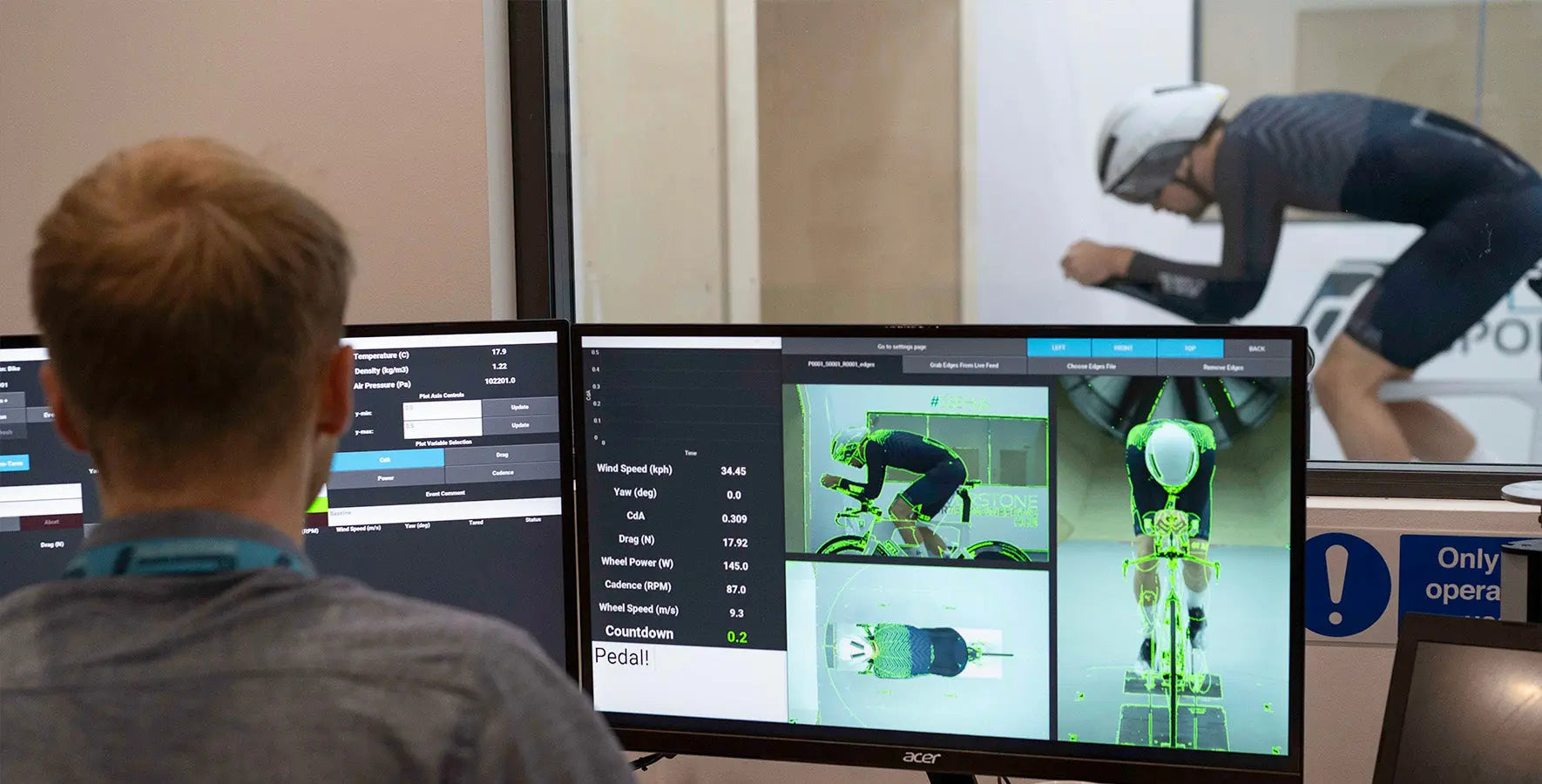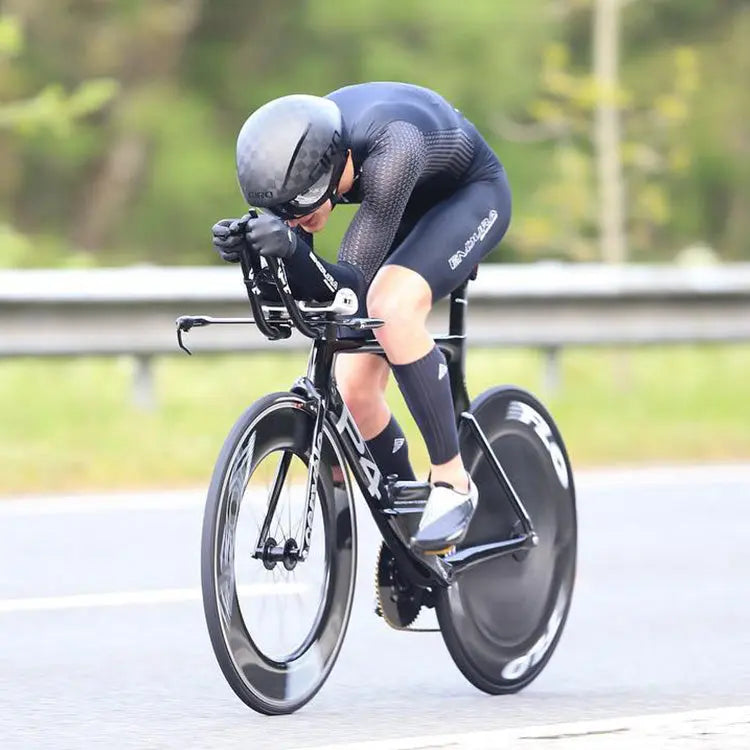The Science of Aerodynamics in Cycling
Aerodynamics plays a crucial role in cycling performance, as it directly impacts the rider's speed, efficiency, and overall energy expenditure. Here, we'll explore the fundamental principles of aerodynamics, how body shape and position affect drag, the role of clothing in reducing aerodynamic drag, and practical tips to help cyclists optimise their performance.
Introduction to Aerodynamic Principles
Aerodynamics is the study of the motion of air and its effects on solid bodies, such as a cyclist and their bicycle. The key concept in aerodynamics is drag, which is the force that opposes the motion of an object through the air. Drag is influenced by several factors, including the object's shape, size, and orientation relative to the direction of motion.
What are main types of aerodynamic drag in cycling?
-
Pressure Drag: This is the drag generated by the difference in air pressure generated by an object moving through the air. High pressure in front and low pressure behind create a push and pull force that works to slow an object down. This is the primary contributor to a cyclist's overall drag.
-
Skin Friction Drag: This is the drag caused by the air flowing over the surface of the cyclist's body and the bicycle. Skin friction drag is influenced by the smoothness and texture of the surfaces.
Understanding these fundamental principles of aerodynamics is crucial for cyclists who want to minimize their drag and improve their performance.
Body Shape and Riding Position
The shape and position of a cyclist's body have a significant impact on aerodynamic drag. The more streamlined the body, the lower the drag. Cyclists can optimise their body shape and position in several ways:
- Tucked Position: in general, adopting a low, position by bending the elbows and keeping the head low can significantly reduce pressure drag. This position minimises the exposed frontal area and can create a more streamlined silhouette.
- Arm Positioning: Placing the arms close to the body, with the elbows tucked in, can help reduce your frontal area. Rolling your wrists inwards can also improve aerodynamics.
- Aero Bike Fit: Ensuring the bicycle is properly fitted to the rider's body can optimise their aerodynamic position. This includes adjusting the seat height, handlebar position and width. This is the biggest area of optimisation that can be found in wind tunnel testing. If you’re interested in wind tunnel testing and are base in the UK, book a test session with us here.
What’s important to note here is that the best position isn’t necessarily the most aero position – you need to be able to maintain it. If you are so uncomfortable or don’t have the strength and flexibility to stay in position, it’s not the option for you. If you find a fast position, train your body to be able to maintain it!
Cycling Clothing and Aerodynamics
The clothing worn by cyclists also has a significant impact on aerodynamic drag. Careful selection and use of textiles helps reduce drag and improve performance.
- Textured Fabrics: Certain textured fabrics, such as ribbed surfaces, can be used on bluff body areas (un-aerodynamic shapes like a brick instead of a teardrop), like the arms and lower leg. These textured fabrics can help transition the airflow from laminar to turbulent, which can decrease the size of the wake behind the rider and reduce overall drag.
- Smooth Fabrics: In contrast, smooth, tight-fitting fabrics are used on areas where a laminar (smooth) airflow is desired, such as the back and hips. These fabrics minimise skin friction drag and help maintain a streamlined profile.
- Tight-Fitting Clothing: Loose or baggy clothing can create pockets of turbulent airflow, increasing drag. Very tight kit however is also a bad idea. This will pull the fibres of the fabric apart and increase skin friction. The sweet spot you want is wrinkle free, but not much more than that.
- Helmet Choice: This something that’s dependant on your event and body shape too. For TT riders, larger sizes typically test faster than smaller sizes as they will help to deflect more air around your shoulders. This is another important option that’s tested in the wind tunnel.
Tips for Reducing Aerodynamic Drag in Cycling
Here are some practical tips that cyclists can implement to reduce their aerodynamic drag and improve their cycling performance:
- Optimise Body Position: Adopt a low, aerodynamic riding position by bending the elbows, keeping the head low and in line with your shoulders, and maintaining a straight, streamlined body position.
- Adjust Bike Fit: Ensure your bicycle is properly fitted to your body, with the seat height, handlebar position, and other components adjusted to achieve the most efficient position that you can maintain for your race duration.
- Choose quality kit that fits: Choose form-fitting, aerodynamic clothing that minimizes pockets of turbulent airflow.
- Select an Aerodynamic Helmet: This will vary from person to person, but we’ve typically seen than the Kask Mistral performs well on many people
- Maintain a Smooth Bike Surface: Ensure your bicycle is well-maintained, with a smooth, clean surface to minimize skin friction drag.
- Reduce Exposed Surface Area: Tuck in any loose clothing or accessories, such as shoelaces to minimize exposed surface area and reduce drag.
- Optimize Wheel and tyre Selection: Choose aerodynamic wheels paired with a tyre that’s as new as possible with good aero credentials and rolling resistance numbers. A good guide can be found here for this. If you're riding on a smooth surface you typically want your tyre to be ~5% narrower than your wheel. Measure this on the wheel, dont rely on what the manufacturer lists the tyre as as this will vary depending on your wheel shape.
- Practice Consistency: Develop a smooth, consistent pedalling technique to maintain an optimal aerodynamic position throughout your ride. Don’t do anything on race day that you haven’t tested in training.
By implementing these tips, cyclists can significantly reduce their aerodynamic drag and improve their overall cycling performance, speed, and efficiency.



